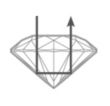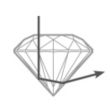Diamonds- The Four Cs
To determine a diamond's value, experts use the Four Cs—cut, color, clarity, and carat weight.
Cut
A diamond’s overall proportions, as well as the size and position of its facets, make up the cut. The consistency and balance of these can greatly affect how the stone captures light and reflects it back to the eye.
Studies have been conducted to find the optimum proportions of a diamond’s cut so that it has the greatest amount of sparkle. If its cut falls within these parameters, it is considered an ideal cut. Commonly used terms regarding refraction and light:
- Brilliance—the combination of all of the white light reflected from the surface and the inside of the diamond.
- Dispersion—flashes of color you see in a polished diamond. Dispersion is also known as fire.
- Scintillation—flashes of light you see when the diamond, the light, or the observer moves.

Too Shallow
If a diamond is too shallow, light will escape from the bottom of the gemstone.

Ideal
When a diamond is cut with the ideal proportions, light enters the diamond and is returned through the top of the diamond.

Too Deep
If it is cut too deep, light will escape from the pavilion.
Color
One factor that determines the value of a diamond is its color. With the exception of fancy-colored diamonds, the most valuable diamonds are those with the least color. Although many people think of gem-quality diamonds as colorless, completely colorless diamonds are very rare.
Each letter grade represents a range of color that is determined by a manual process of comparing the diamond to a master set.
| DEF | GHIJ | KLM | NOPQR | STUVWXY | Z+ |
|---|---|---|---|---|---|
| Colorless | Near Colorless | Faint Yellow | Very Light Yellow | Light Yellow |
Fancy |
Clarity
A diamond’s clarity is measured by the existence or absence of visible flaws. Tiny surface blemishes or internal inclusions, even those seen only under magnification, can alter the brilliance of the diamond and thus affect its value.
|
FL |
Flawless: No internal or external clarity characteristics |
|
IF |
Internally Flawless: No internal clarity characteristics |
|
VVS1, VVS2 |
Very, Very Slightly Included: Difficult to see under 10X magnification |
|
VS1, VS2 |
Very Slightly Included: Inclusions not typically visible to the unaided eye |
|
SI1, SI2 |
Slightly Included: Visible under 10X magnification and may be visible to the unaided eye |
|
I1, I2, I3 |
Included: Inclusions visible to the unaided eye |
Carat Weight
Carat refers to the diamond’s weight. You may also hear the weight of a diamond referred to in points. One carat is equivalent to 100 points, so a 75-point diamond is equal to 0.75 carats. Because they are rarer, larger diamonds have a greater value per carat. Therefore, the price of a diamond rises exponentially in regards to its size.
Carat to Millimeter Size Reference
| MM | 4.2 | 5.2 | 5.6 | 5.8 | 6.5 | 7.0 | 7.4 | 7.8 | 8.2 | 8.8 | 9.4 | 10.4 | 11.2 |
 |
 |
 |
 |
 |
 |
 |
 |
 |
 |
 |
 |
 |
|
| CT | 3⁄8 | 1⁄2 | 5⁄8 | 3⁄4 | 1.0 | 1.25 | 1.50 | 1.75 | 2.0 | 2.50 | 3.0 | 4.0 | 5.0 |









Leave a comment
All blog comments are checked prior to publishing